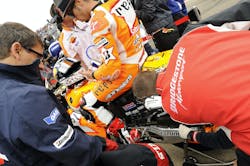This season the Aragon GP was held for the second time after its inaugural running last year, giving those teams and riders who competed last time, and Bridgestone, the benefit of experience. The race weekend started unusually when Friday afternoon practice was postponed until Saturday morning following a power cut in the region that left the circuit without electricity. Conditions on Friday and Saturday were very hot, but by race-day the clouds gathered and blocked the sunlight whilst a strong wind blew and ensured the temperature was much lower. Nevertheless, Casey Stoner set a new pole position record and a new lap record on his way to victory, ahead of Dani Pedrosa and Jorge Lorenzo. Tyre wear was a big feature in the race and good tyre management and an efficient setup were especially important.
Masao Azuma – Chief Field Engineer, Bridgestone Motorsport
What can you say about tyre wear in the race?
“Tyre wear was of course a crucial factor in the race, but within our expectations. Tyre wear was faster for some than others, as you would expect, but for example we can see from Casey that although his laptimes slowed after about mid-race distance, they did so consistently and manageably.
“At this high level of motorcycle racing tyre compound selection is always a balance between warm-up performance and race-distance durability. You maximise one at the detriment of the other. This season riders have specifically been asking for tyres that have improved warm-up performance for improved safety in the early laps and were happy to sacrifice some race-distance durability for this, and this is exactly what we saw happen on Sunday.
“A look at the laptimes indicates that the warm-up performance of our tyres was very good today even though the track temperature was 13 degrees Celsius cooler than last year’s Aragon GP. Casey was under the previous record on just his second lap of the race whilst his new record was set on lap four, and the top ten fastest riders all set their best within the opening six laps so you can’t ask for much more in terms of warm-up. And as I just said the flip-side of this, as the riders know, is that tyre performance will drop off later in the race as durability is not as good.
“The tarmac and conditions at Aragon also encouraged tyre wear – the circuit started off quite dirty on Friday and tyre wear was quite high then, again as you’d expect. As it cleaned through the weekend, the wear appearance improved but by the race it was still dirty off-line so those riders who were in battles would have suffered more from this as they moved off the ideal line to attack or defend. Tyre wear on Sunday was not a problem, it was just a factor of the above.”
Why was there a step in front tyre compounds from Medium to Extra Hard?
“We know from last year and our continued analysis of the circuit and its characteristics that front tyre stability would be crucial, especially under heavy braking into the downhill corners, and that good wear resistance and durability would be important. The medium and the extra hard compounds have a very similar temperature operating range so can be used in the same ambient conditions, but we selected the medium compound slicks for their better grip, which worked well for Álvaro and Suzuki, and the extra hard compound for better stability and wear rate. Given the conditions, these were favoured by the majority of riders for the race.”



